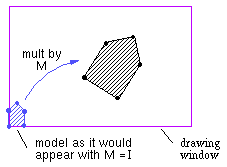Using Geometric Transformations
Hill: 247-251
 The simplest method of modelling objects is to use primitives such as lines
and polygons. In the following, M is the desired transformation matrix
which transforms points (2D or 3D) to pixel coordinates.
The simplest method of modelling objects is to use primitives such as lines
and polygons. In the following, M is the desired transformation matrix
which transforms points (2D or 3D) to pixel coordinates.
for each vertex i
new_vertex_list[i] = M * vertex_list[i]
scanconvert( new_vertex_list )
Here is the equivalent in OpenGL:.
glBegin(GL_POLYGON);
for each vertex i
glVertex3fv( vertex_list[i] );
glEnd();
There are several things to note:
-
glVertex3fv() :
-
multiplies vertex by M
-
feeds points to scan conversion
-
glBegin() : specifies drawing mode
-
GL_POINTS
-
GL_LINE_LOOP
-
GL_POLYGON
-
...
-
matrix M is hidden ( current transformation matrix)
M can be setup as follows:
glMatrixMode( GL_MODELVIEW );
glLoadIdentity();
glTranslatef(2.0, 1.0, 0.0);
glRotatef( -3.14/2.0, 0.0, 0.0, 1.0);
glScalef(2.0, 2.0, 2.0);
...
which produces the matrix M = trans(2,1,0) rot(z,-90) scale(2,2,2)
....
Another way of loading M is to use:
glMatrixMode( GL_MODELVIEW );
glLoadMatrixf( M );
Transformation Hierarchies
Hill: 254-255 (explains push and pop)
Consider building the following model of a hand with one finger::
 This can be constructed using a transformation hierarchy. In the following
scene graph, circles represent transformations and squares represent
geometry. The pseudocode on the left can be used to draw the scene.
This can be constructed using a transformation hierarchy. In the following
scene graph, circles represent transformations and squares represent
geometry. The pseudocode on the left can be used to draw the scene.
f1: trans(d_hand,0,0) rot(z,th1)
f2: trans(d1,0,0) rot(z,th2)
f3: trans(d2,0,0) rot(z,th3)
M=M*Thand
draw hand
M=M*Tf1
draw f1
M=M*Tf2
draw f2
M=M*Tf3
draw f3 |
 |
Now consider drawing a hand with three identical fingers. We can create
a more complex scene graph which uses multiple instances of a finger scene
graph, as shown below. Because each of the fingers is defined relative
to the hand coordinate system, a way is needed to restore the hand coordinate
system before beginning to draw each finger. This is done through the pushMatrix()
and popMatrix() function calls.
M=M*Thand
draw hand
pushMatrix()
M=M*Tf1a
draw_finger()
popMatrix()
pushMatrix()
M=M*Tf1b
draw_finger()
popMatrix()
pushMatrix()
M=M*Tf1c
draw_finger()
popMatrix()
draw_finger() {
draw f1
M=M*Tf2
draw f2
M=M*Tf3
draw f3
}
|
 |
Many graphics systems maintain a stack for the current transformation matrix:





